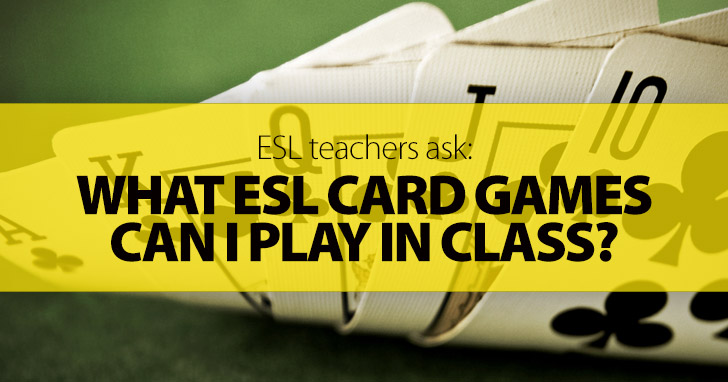“I love playing card games with my ESL students, but I find it hard to stray from the classic Go Fish or Snap. What are some other card games I can play with my class?” *
There probably isn’t an ESL teacher out there who doesn’t love card games. They’re tremendously versatile, as you can use them to practice anything from verb tenses to vocabulary. The cards are also easy to carry and keep handy for any last minute changes you need to make to your lesson plan. But, it’s also true that we tend to play the same games – again and again. So if you want to add some variety to the card games you play, here are some great options you might want to try. Some may be new to you, while others are simply a new spin on an old favorite.

Try These 6 Card Games with Your ESL Class
-
1
Go Fish
Now, Go Fish is a popular choice and one of the card games you can adapt to suit many different grammar points. To make the game more adaptable, simply use cards with verbs in their base form (eat, drink, buy, live). Have two sets of verb cards, so you have two of each verb. You can play the game in pairs or in small groups. Each student is dealt five to seven cards (the remaining cards are placed in a stack at the center) and has to ask a question in the correct grammar tense in order to find the pair. So, if you’re practicing questions with ever, and Student A has a card with the verb be, he/she asks, “Have you ever been to ….?” If student B has the card with the verb be, he/she must say, “Yes, I have” and hand it over. If not, he/she says, “No, I haven’t! Go fish!”, thus prompting Student A to take a card from the stack of remaining cards. For another great spin on the Go Fish card game, check out this worksheet.
-
2
Snap!
In the game of Snap!, you have two students holding one deck of cards each, and they take turns turning the top card of each deck over to see if their cards match. If they match, they shout, “Snap!” Now, you can adapt this game and redefine what it means to have cards that match. You can define two cards as matching when:
- One is a signal word and the other is a verb in the right tense (one card says ago and the other card says went)
- One is an article and the other a noun that matches it (an and apple).
- One is a verb and the other is a noun that matches it (do and homework)
- One is a noun or a verb, and the other is a suffix, as in this Suffixes Snap Game
- One is an illustration and the other is the corresponding word, as in this Food Snap
-
3
Memory Game
The classic Memory Game features two sets of identical cards that are mixed up and placed face down while students turn them over two at a time with the goal of finding a pair. But let’s put a spin on this classic, shall we? You can have one set of verbs and another of prepositions and have students find the right matches (agree with, talk about) or just like in Snap!, verbs and signal words.
-
4
Action Cards
This is a form of charades. Write a set of actions in imperative form on a set of cards. Separate the students into two teams. A student in Team A takes a card and performs the action. Someone in the team has to say what he/she is doing (She’s opening the window). If the statement is correct, the team gets to keep the card. The team with the most cards wins.
-
5
Taboo
Another classic in the ESL class, in the game of Taboo, a student is given a card with a word he/she must define/explain but without using any of the words underneath. You can use this worksheet for a Health and Body Taboo, or create your own with any vocabulary you want to practice.
-
6
Discussion Discard
Prepare a set of 10 to 12 cards with expressions students will need to use in a discussion. These may include ways of agreeing/disagreeing (“You may have a point there, but…”; “I strongly disagree”), ways of expressing opinions (“I think/believe that…”) or interrupting (“If I may say something here…”). Divide the class into pairs (you’ll need to have one set of cards for each pair). Each student gets five cards. Give each pair a topic to discuss. Each student must try to use the expressions that are written on the cards they have been dealt. Once they use a card, they put it face down on the table. The goal of the game is to be the last person to put down a card.
You don’t need to have many different types of card games or cards. What you need is a set of very adaptable games that you can modify to suit your needs. This way, you’ll have many more versions of the same games.
Do you have any other card games/variations to add to the list?
Please share them below!
* This question was sent in from a real ESL teacher, just like you! If you have a question you’d like to have answered, share it in the comments below. Or tweet your question to @busyteacher_org with the hashtag #ESLTeachersAsk. Your question might get picked and featured in an article!
P.S. If you enjoyed this article, please help spread it by clicking one of those sharing buttons below. And if you are interested in more, you should follow our Facebook page where we share more about creative, non-boring ways to teach English.







